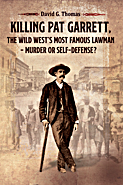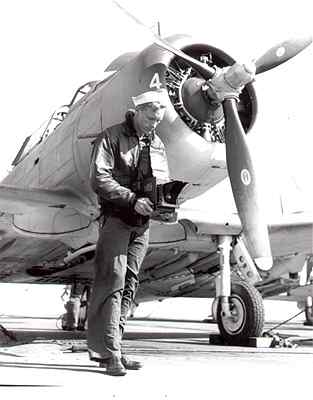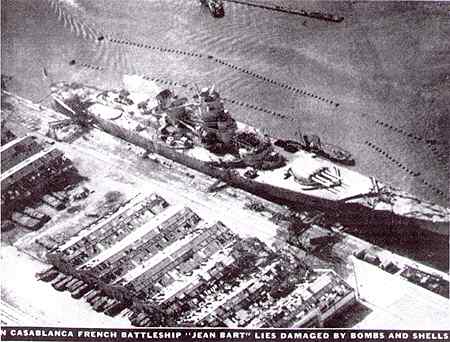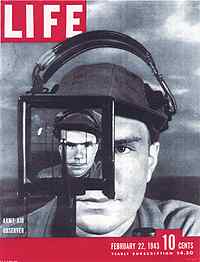|
|
||||||||||||||||||||||||
 |
||||||||||||||||||||||||
|
|
||||||||||||||||||||||||
|
||||||||||||||||||||||||
|
|
||||||||||||||||||||||||
 |
||||||||||||||||||||||||
 |
||||||||||||||||||||||||
 |
||||||||||||||||||||||||
|
|
||||||||||||||||||||||||
|
|
"Bring Back the Handles" |
|
By Bill Wade, AG-4 |
|
The date was November 1942. A large armada of British and US warships gathered off the northwest coast of Africa for the start of the "Torch" campaign. This was the beginning of the allied invasion of Africa. Among these ships was the USS Ranger, the first ship designed and built as an aircraft carrier by the US Navy. In this campaign, she launched planes for bombing and strafing sorties against German and Vichy French targets around Casablanca. One of the primary targets was a Vichy French battleship, the Jean Bart, at a pier in the harbor of Casablanca. Dive bombers from the Ranger attacked her many times, but pilots brought back conflicting reports of the resulting damage. Some of Ranger's pilots stated that they had blasted this battleship unmercifully, while other pilots reported she was undamaged. To resolve this confusion, the Ranger decided to send a photographer to bring back photos that could be closely analyzed. When I was assigned to this mission, I was a 21-year-old Photographers Mate Third Class, recently graduated from the Naval School of Photography in Pensacola, Florida. With an aerial camera almost a yard long, I climbed into the rear cockpit of an SBD dive bomber piloted by Lt (jg) Clyde A. Tucker (*). Our carrier takeoff and flight to French Morocco were routine as I double checked camera settings and reviewed my recent schooling, hoping for good photos in the target area.
After hours of flying over the empty gray sea, Lt (jg) Tucker told me over the intercom that he was having trouble find the ship and that our fuel supply was getting low. He told me to throw everything I could out of the rear cockpit to lighten the plane. I jettisoned everything removable from the cockpit but could not bring myself to throw out the camera. As I wrestled with this decision, the term "direct disobedience of orders" went through my mind. Then I thought of a class at the photo school taught by a crusty old Chief. One of my fellow students asked him what would happen if we dropped a camera from a plane. He replied, "No problem, if you bring back the handles." Since the handles are permanently attached to the camera, we got the message. This firmed up my decision. After what seemed an eternity, we saw the Ranger in the distance and with our gas running low, we were given permission for a direct approach and landing.
Months later, I found that LIFE Magazine had published one of the Jean Bart photos as one of "the best battle photos of the war" in the February 22, 1943 issue. I couldn't help feeling a little proud and very glad that I "brought back the handles!"
After the War I was discharged on November 14, 1945 (I joined November 4, 1939 on a 6-year enlistment). I took advantage of the GI Bill by attending Cornell and obtaining a degree in Civil Engineering. I then worked for Chiquita Brands International (formerly United Fruit Company) for 26 years. While this by no means left me wealthy, it did give me the chance to travel on business all over the world, which I enjoyed. After retiring from Chiquita, I operated my own consulting firm doing engineering for banana producers (irrigation, drainage, packing stations, etc.), but am now almost fully retired. |
|
Air Group 4 - "Casablanca to Tokyo" |
|||
|
|
|||



